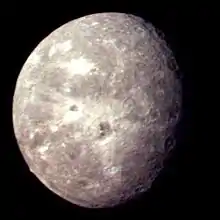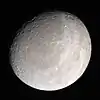အိုဘရွန် (ဂြိုဟ်ရံလ)
အိုဘရွန် သည် ယူရေးနပ်စ်ဂြိုဟ်၏ ၄ ခုမြောက် အပြင်ဘက်အကျဆုံး ဂြိုဟ်ရံလတစ်စင်းဖြစ်သည်။ ယင်းသည် ယူရေးနပ်စ်ဂြိုဟ်၏ ဒုတိယအကြီးဆုံးနှင့် နေအဖွဲ့အစည်းတွင် နဝမမြောက် အကြီးဆုံး ဂြိုဟ်ရံလဖြစ်သည်။ ၁၇၈၇ ခုနှစ်တွင် ဝီလီယံ ဟာရှယ်က ရှာဖွေတွ့ရှိခဲ့ပြီး အိုဘရွန်သည် ယူရေးနပ်စ်၏ မက်ဂနက်တိုစဖီးယားအလွှာ အပြင်ဘက်တစ်စိတ်တပိုင်းမှ လှည့်ပတ်လျက်ရှိသည်။ မြေမျက်နှာပြင်သည် အနက်ရောင်နှင့် အနီရောင် အနည်းငယ်သမ်းကာ ဥက္ကာခဲများ၊ ကြယ်တံခွန်များ၏ ထိတိုက်မှုကြောင့် အမာရွတ်များ ထင်ကျန်လျက်ရှိသည်။ ၁၉၈၆ ခုနှစ်က ဗွိုင်ယေဂျာ ၂၏ ယူရေးနပ်စ်ဂြိုဟ်အနား ချဉ်းကပ်ပျံသန်းခဲ့စဉ်က အိုဘရွန်၏ ၄၀ ရာခိုင်နှုန်းသောမြေပုံအား ဖော်ထုတ်နိုင်ခဲ့သည်။
 The best Voyager 2 image of Oberon[caption 1] | |
| ရှာဖွေတွေ့ရှိခြင်း | |
|---|---|
| ရှာဖွေတွေ့ရှိခဲ့သူ | ဝီလီယံ ဟာရှယ် |
| ရှာဖွေတွေ့ရှိသည့် ရက်စွဲ | January 11, 1787[1] |
| အသံထွက် | /ˈoʊbərɒn/ |
အခြားအမည်များ | Uranus IV |
| ပါဝင်အရာဝတ္ထုများ | Oberonian[2] |
| ပတ်လမ်း ဂုဏ်အင်များ | |
ဆီမီး မေဂျာ ဝင်ရိုး | 583520 km[3] |
| ပတ်လမ်း ဗဟိုကျမှု | 0.0014[3] |
ပတ်လမ်း ကာလ | 13.463234 d[3] |
ပျမ်းမျှ ပတ်နှုန်း | 3.15 km/s (calculated) |
| ပတ်လမ်း တိမ်းစောင်းမှု | 0.058° (to Uranus's equator)[3] |
| ဂြိုဟ်ရံလများ | ယူရေးနပ်စ်ဂြိုဟ် |
| ရုပ်ပိုင်းဆိုင်ရာ ဂုဏ်အင်များ | |
ပျမ်းမျှ အချင်းဝက် | 761.4±2.6 km (0.1194 Earths)[4] |
မျက်နှာပြင် ဧရိယာ | 7285000 km2[မှတ်စု 1] |
| ထုထည် | 1849000000 km3[မှတ်စု 2] |
| အရွယ်အစား | (3.014±0.075)×1021 kg (5.046×10−4 Earths)[5] |
ပျမ်းမျှ သိပ်သည်းဆ | 1.63±0.05 g/cm³[5] |
မျက်နှာပြင် ဒြပ်ဆွဲအား | 0.346 m/s²[မှတ်စု 3] |
လွတ်မြောက်အလျင် | 0.727 km/s[မှတ်စု 4] |
လှည့်ပတ်ကာလ | presumed synchronous[6] |
| Albedo |
|
| အပူချိန် | 70–80 K[8] |
မြင်သာသော အရွယ်အစား | 14.1[9] |
| လေထု | |
မျက်နှာပြင် လေထုဖိအား | zero |
မှတ်စု
- A number of bright-rayed craters are visible. Hamlet, just below center, has dark material on its floor; to its upper left is smaller Othello. Above the limb at lower left rises an 11 km high mountain, probably the central peak of another crater. Mommur Chasma runs along the terminator at upper right.
- Surface area derived from the radius r: .
- Volume v derived from the radius r: .
- Surface gravity derived from the mass m, the gravitational constant G and the radius r: .
- Escape velocity derived from the mass m, the gravitational constant G and the radius r: √2Gm/r.
ကိုးကား
- Herschel, W. S. (1787). "An Account of the Discovery of Two Satellites Revolving Round the Georgian Planet". Philosophical Transactions of the Royal Society of London 77: 125–129. doi:.
- Shakespeare၊ William (1935)။ A midsummer night's dream။ Macmillan။ p. xliv။ ISBN 0-486-44721-9။
- Planetary Satellite Mean Orbital Parameters။ Jet Propulsion Laboratory, California Institute of Technology။
- Thomas, P. C. (1988). "Radii, shapes, and topography of the satellites of Uranus from limb coordinates". Icarus 73 (3): 427–441. doi:. Bibcode: 1988Icar...73..427T.
- "The masses of Uranus and its major satellites from Voyager tracking data and earth-based Uranian satellite data" (June 1992). The Astronomical Journal 103 (6): 2068–2078. doi:. Bibcode: 1992AJ....103.2068J.
- "Voyager 2 in the Uranian System: Imaging Science Results" (4 July 1986). Science 233 (4759): 43–64. doi:. PMID 17812889. Bibcode: 1986Sci...233...43S.
- Karkoschka, Erich (2001). "Comprehensive Photometry of the Rings and 16 Satellites of Uranus with the Hubble Space Telescope". Icarus 151 (1): 51–68. doi:. Bibcode: 2001Icar..151...51K.
- "Distributions of H2O and CO2 ices on Ariel, Umbriel, Titania, and Oberon from IRTF/SpeX observations" (October 2006). Icarus 184 (2): 543–555. doi:. Bibcode: 2006Icar..184..543G.
- Newton၊ Bill; Teece၊ Philip (1995)။ The guide to amateur astronomy။ Cambridge University Press။ p. 109။ ISBN 978-0-521-44492-7။
This article is issued from Wikipedia. The text is licensed under Creative Commons - Attribution - Sharealike. Additional terms may apply for the media files.
